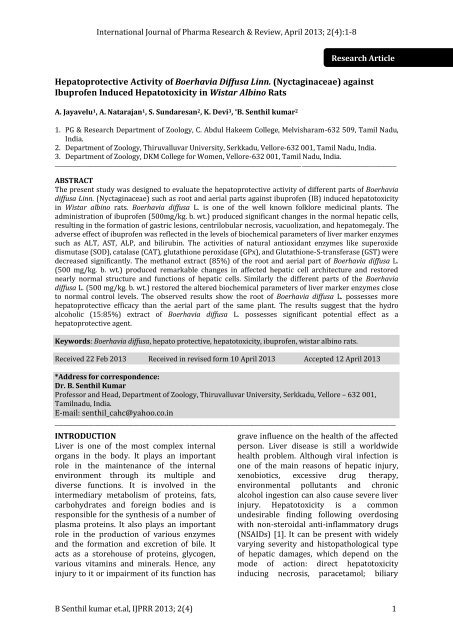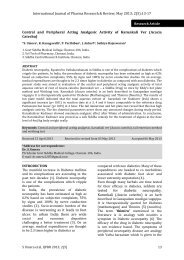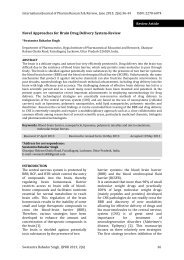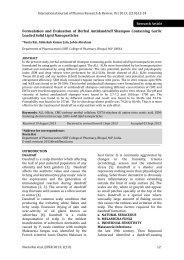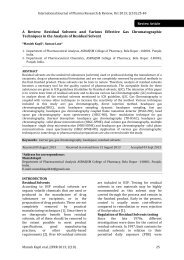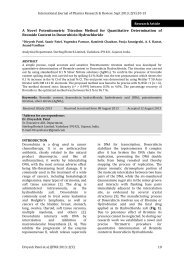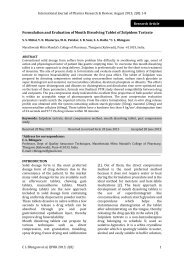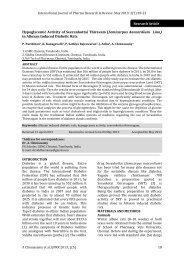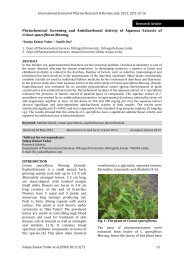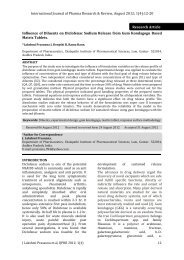Hepatoprotective Activity of Boerhavia Diffusa Linn. - International ...
Hepatoprotective Activity of Boerhavia Diffusa Linn. - International ...
Hepatoprotective Activity of Boerhavia Diffusa Linn. - International ...
Create successful ePaper yourself
Turn your PDF publications into a flip-book with our unique Google optimized e-Paper software.
<strong>International</strong> Journal <strong>of</strong> Pharma Research & Review, April 2013; 2(4):1-8<br />
Research Article<br />
<strong>Hepatoprotective</strong> <strong>Activity</strong> <strong>of</strong> <strong>Boerhavia</strong> <strong>Diffusa</strong> <strong>Linn</strong>. (Nyctaginaceae) against<br />
Ibupr<strong>of</strong>en Induced Hepatotoxicity in Wistar Albino Rats<br />
A. Jayavelu 1 , A. Natarajan 1 , S. Sundaresan 2 , K. Devi 3 , * B. Senthil kumar 2<br />
1. PG & Research Department <strong>of</strong> Zoology, C. Abdul Hakeem College, Melvisharam-632 509, Tamil Nadu,<br />
India.<br />
2. Department <strong>of</strong> Zoology, Thiruvalluvar University, Serkkadu, Vellore-632 001, Tamil Nadu, India.<br />
3. Department <strong>of</strong> Zoology, DKM College for Women, Vellore-632 001, Tamil Nadu, India.<br />
_____________________________________________________________________________________________________________________________ ________________________________________________<br />
ABSTRACT<br />
The present study was designed to evaluate the hepatoprotective activity <strong>of</strong> different parts <strong>of</strong> <strong>Boerhavia</strong><br />
diffusa <strong>Linn</strong>. (Nyctaginaceae) such as root and aerial parts against ibupr<strong>of</strong>en (IB) induced hepatotoxicity<br />
in Wistar albino rats. <strong>Boerhavia</strong> diffusa L. is one <strong>of</strong> the well known folklore medicinal plants. The<br />
administration <strong>of</strong> ibupr<strong>of</strong>en (500mg/kg. b. wt.) produced significant changes in the normal hepatic cells,<br />
resulting in the formation <strong>of</strong> gastric lesions, centrilobular necrosis, vacuolization, and hepatomegaly. The<br />
adverse effect <strong>of</strong> ibupr<strong>of</strong>en was reflected in the levels <strong>of</strong> biochemical parameters <strong>of</strong> liver marker enzymes<br />
such as ALT, AST, ALP, and bilirubin. The activities <strong>of</strong> natural antioxidant enzymes like superoxide<br />
dismutase (SOD), catalase (CAT), glutathione peroxidase (GPx), and Glutathione-S-transferase (GST) were<br />
decreased significantly. The methanol extract (85%) <strong>of</strong> the root and aerial part <strong>of</strong> <strong>Boerhavia</strong> diffusa L.<br />
(500 mg/kg. b. wt.) produced remarkable changes in affected hepatic cell architecture and restored<br />
nearly normal structure and functions <strong>of</strong> hepatic cells. Similarly the different parts <strong>of</strong> the <strong>Boerhavia</strong><br />
diffusa L. (500 mg/kg. b. wt.) restored the altered biochemical parameters <strong>of</strong> liver marker enzymes close<br />
to normal control levels. The observed results show the root <strong>of</strong> <strong>Boerhavia</strong> diffusa L. possesses more<br />
hepatoprotective efficacy than the aerial part <strong>of</strong> the same plant. The results suggest that the hydro<br />
alcoholic (15:85%) extract <strong>of</strong> <strong>Boerhavia</strong> diffusa L. possesses significant potential effect as a<br />
hepatoprotective agent.<br />
Keywords: <strong>Boerhavia</strong> diffusa, hepato protective, hepatotoxicity, ibupr<strong>of</strong>en, wistar albino rats.<br />
Received 22 Feb 2013 Received in revised form 10 April 2013 Accepted 12 April 2013<br />
*Address for correspondence:<br />
Dr. B. Senthil Kumar<br />
Pr<strong>of</strong>essor and Head, Department <strong>of</strong> Zoology, Thiruvalluvar University, Serkkadu, Vellore – 632 001,<br />
Tamilnadu, India.<br />
E-mail: senthil_cahc@yahoo.co.in<br />
_________________________________________________________________________________________________________________________<br />
INTRODUCTION<br />
Liver is one <strong>of</strong> the most complex internal<br />
organs in the body. It plays an important<br />
role in the maintenance <strong>of</strong> the internal<br />
environment through its multiple and<br />
diverse functions. It is involved in the<br />
intermediary metabolism <strong>of</strong> proteins, fats,<br />
carbohydrates and foreign bodies and is<br />
responsible for the synthesis <strong>of</strong> a number <strong>of</strong><br />
plasma proteins. It also plays an important<br />
role in the production <strong>of</strong> various enzymes<br />
and the formation and excretion <strong>of</strong> bile. It<br />
acts as a storehouse <strong>of</strong> proteins, glycogen,<br />
various vitamins and minerals. Hence, any<br />
injury to it or impairment <strong>of</strong> its function has<br />
grave influence on the health <strong>of</strong> the affected<br />
person. Liver disease is still a worldwide<br />
health problem. Although viral infection is<br />
one <strong>of</strong> the main reasons <strong>of</strong> hepatic injury,<br />
xenobiotics, excessive drug therapy,<br />
environmental pollutants and chronic<br />
alcohol ingestion can also cause severe liver<br />
injury. Hepatotoxicity is a common<br />
undesirable finding following overdosing<br />
with non-steroidal anti-inflammatory drugs<br />
(NSAIDs) [1]. It can be present with widely<br />
varying severity and histopathological type<br />
<strong>of</strong> hepatic damages, which depend on the<br />
mode <strong>of</strong> action: direct hepatotoxicity<br />
inducing necrosis, paracetamol; biliary<br />
B Senthil kumar et.al, IJPRR 2013; 2(4) 1
<strong>International</strong> Journal <strong>of</strong> Pharma Research & Review, April 2013; 2(4):1-8<br />
toxicity inducing cholestasis,<br />
alphanaphthylisothiocyanate (ANIT),<br />
ibupr<strong>of</strong>en; steatosis, tetracyclins,<br />
hypertrophia, hyperplasia, hepatitis, etc. [2].<br />
Ibupr<strong>of</strong>en [2-(4-isobutylphenyl) propionic<br />
acid] is a nonsteroidal antiinflammatory<br />
drug (NSAID) <strong>of</strong> the 2-aryl propionic acid<br />
family [3, 4]. Ibupr<strong>of</strong>en is commonly<br />
prescribed for the treatment <strong>of</strong> fever,<br />
inflammation, and pain [5]. It is commonly<br />
known to produce hepatotoxicity, inducing<br />
cholestatic hepatitis [1]. Besides, ibupr<strong>of</strong>en<br />
was also found to be most active in<br />
impairing gluconeogenesis from lactate, and<br />
in impairing albumin synthesis in vitro [6].<br />
Lower dose <strong>of</strong> ibupr<strong>of</strong>en also induces more<br />
histopathological lesions in rats’ liver than<br />
chlorpromazine, paracetamol and other [2].<br />
In this context, ibupr<strong>of</strong>en was used in the<br />
present study to induce hepatotoxicity in<br />
rats as a representative toxin <strong>of</strong> the class <strong>of</strong><br />
NSAIDs.<br />
Ibupr<strong>of</strong>en is primarily metabolized by<br />
oxidation in the liver and the major<br />
metabolites are 2-hydroxy ibupr<strong>of</strong>en and 2-<br />
carboxy ibupr<strong>of</strong>en [7]. A wide range <strong>of</strong><br />
possible side effects associated with the use<br />
<strong>of</strong> ibupr<strong>of</strong>en, including gastrointestinal<br />
intolerance, cardiovascular toxicity, renal<br />
toxicity and hepatotoxicity have been<br />
reported. The ibupr<strong>of</strong>en toxicity has been<br />
reviewed extensively in reference [8].<br />
Researchers are now focusing their attention<br />
on identifying and validating plant derived<br />
substances for the treatment <strong>of</strong> various<br />
diseases [9]. Interestingly, it is estimated<br />
that more than 25% <strong>of</strong> modern medicines<br />
are directely or indirectly derived from<br />
plants. Boerhaavia diffusa L.<br />
(Nyctaginaceae), commonly known as<br />
'Punarnava' in the Indian system <strong>of</strong><br />
medicine, is a perennial creeper found<br />
throughout the waste lands <strong>of</strong> India. The<br />
plant which is reputed to be diuretic and<br />
laxative is given for the treatment <strong>of</strong><br />
anasarca, ascites and jaundice [10]. The<br />
plants <strong>of</strong> Boerhaavia diffusa L. had been<br />
found to have diuretic, anti inflammatory,<br />
fibrinolytic, nephrotic syndrome and anticonvulsant<br />
activities [11-13]. It also reported<br />
the hepatoprotective activity <strong>of</strong> the aerial<br />
part <strong>of</strong> the plants. It is <strong>of</strong> importance to note<br />
that the inhibition <strong>of</strong> CYT P450 2E1 and<br />
antioxidant actions seem to be the common<br />
mechanism <strong>of</strong> action <strong>of</strong> herbal drugs. This<br />
plant was known to possess various<br />
medicinal properties like free radical<br />
scavenging activity, hypoglycemic and<br />
antidiabetic and hepatoprotective activity. A<br />
large number <strong>of</strong> compounds have been<br />
isolated from the roots <strong>of</strong> B. diffusa L.namely<br />
punarnavine, β-sitosterol, β-D glucoside<br />
tetracosanoic, hexacosanoic, stearic,<br />
palmitic, arachidonic acid, hentriacontance,<br />
ursolic acid and punarnava-voside.<br />
MATERIALS AND METHODS<br />
Plant Material and Plant extract<br />
preparation<br />
<strong>Boerhavia</strong> diffusa L. were collected from<br />
Thengal in Vellore district <strong>of</strong> Tamilnadu,<br />
India in the month <strong>of</strong> March 2010 during the<br />
early hours <strong>of</strong> the days. The plant was<br />
identified and authenticated by the<br />
department <strong>of</strong> Botany, CAHC, Melvisharam,<br />
Tamil Nadu. The root and aerial part <strong>of</strong> the<br />
plants were separated, shade dried and<br />
powdered in a micro - pulveriser and<br />
subjected to soxhlet extraction, using a<br />
hydroalcohloic (85% methanol) solvent at a<br />
temperature <strong>of</strong> 70ºC. The concentrated<br />
crude extract was lyophilized into powder<br />
and was preserved in an airtight container in<br />
a deep freezer until the time <strong>of</strong> use.<br />
Animals<br />
Thirty six albino rats were used in this study.<br />
Wistar albino rats weighing 175-225g in the<br />
present studies were procured from the<br />
animal house <strong>of</strong> C.Abdul Hakeem College,<br />
Melvisharam, Tamil Nadu, India. The animals<br />
were housed in a clean and well ventilated<br />
experimental unit <strong>of</strong> animal house in<br />
polypropylene cages with sterile inert husk<br />
materials as bedding. All the animals were<br />
kept under standard environmental<br />
condition at 25±2°C (12h light/12h dark<br />
cycle at room temperature) and maintained<br />
on commercial pellet diet, supplied by<br />
“HINDUSTAN LEVER” Limited Mumbai,<br />
under the trade name “Gold Mohar” Feeds,<br />
water was provided ad libitum. Experimental<br />
protocols and procedures with respect to the<br />
animals employed in this study were<br />
approved by the Animal Ethics Committee <strong>of</strong><br />
C. Abdul Hakeem College, Melvisharam,<br />
Tamil Nadu, India. The rats were kept in<br />
animal house for ten days before starting the<br />
experiments.<br />
B Senthil kumar et.al, IJPRR 2013; 2(4) 2
<strong>International</strong> Journal <strong>of</strong> Pharma Research & Review, April 2013; 2(4):1-8<br />
In this study, Silymarin (25 mg/Kg b. wt.)<br />
was used as a standard, against ibupr<strong>of</strong>en<br />
induced acute hepatic damage in Wistar<br />
albino rats. It was undertaken to determine<br />
the hepatoprotective activities <strong>of</strong> the<br />
methanol extract <strong>of</strong> root and methanol<br />
extract <strong>of</strong> aerial part <strong>of</strong> <strong>Boerhavia</strong> diffusa<br />
<strong>Linn</strong>. in an animal model. In addition, to find<br />
the levels <strong>of</strong> liver marker enzymes,<br />
histopathological studies were done to prove<br />
their efficacy <strong>of</strong> preventive and curative role<br />
against ibupr<strong>of</strong>en toxicity in vivo.<br />
Experimental design<br />
Ibupr<strong>of</strong>en (IB) was obtained from Indian<br />
Pharmaceutical Company (IPCA) Mumbai.<br />
The animals were divided into six groups<br />
consisting <strong>of</strong> six animals each for different<br />
experiments.<br />
Group I rats which served as normal control<br />
received commercial feed and distilled<br />
water,<br />
Group II (intoxicated group) administrated<br />
orally by gavage, with a single dose <strong>of</strong><br />
ibupr<strong>of</strong>en (500 mg/kg b. wt.) dissolved in<br />
water (37 0 C).<br />
Group III was given IB with single dose (500<br />
mg/kg, b. wt.) followed by sylimarine<br />
(Standard) commercial drug (25 mg/kg, b.<br />
wt.) for 30 days.<br />
Group IV were intoxicated with IB (500<br />
mg/kg b. wt.) followed by the methanol<br />
extract <strong>of</strong> the root <strong>of</strong> <strong>Boerhavia</strong> diffusa (500<br />
mg/kg b. wt.) for 30 days.<br />
Group V were intoxicated with IB (500<br />
mg/kg b. wt.) followed by the methanol<br />
extract <strong>of</strong> the aerial part <strong>of</strong> <strong>Boerhavia</strong> diffusa<br />
(500 mg/kg b. wt.) for 30 days.<br />
Induction <strong>of</strong> Liver damage<br />
Liver damage was induced by the<br />
administration <strong>of</strong> ibupr<strong>of</strong>en orally with<br />
single dose (500mg/kg body weight) in rats.<br />
After the completion <strong>of</strong> experimental course<br />
<strong>of</strong> therapy the rats were fasted over night<br />
and blood samples were collected by cervical<br />
dislocation under light ether anesthesia.<br />
Serum samples were used for the<br />
determination <strong>of</strong> various parameters.<br />
Preparation <strong>of</strong> hepatic homogenate<br />
The liver was quickly removed, part <strong>of</strong> the<br />
liver perfused immediately with ice-cold<br />
saline (0.9% NaCl), Portion <strong>of</strong> the liver was<br />
then homogenized in chilled sodium<br />
phosphate buffer (0.1M, pH 7.4) using a<br />
Potter Elvehjehm Teflon homogenizer<br />
(Yamato L.S. G. L.H-21, Japan). The<br />
homogenate thus obtained was centrifuged<br />
in a cooling centrifuge at 12,000 rpm for 30<br />
min at 4 0 C to obtain a post-mitochondrial<br />
supernatant (PMS), which was used for<br />
evaluation <strong>of</strong> liver endogenous antioxidant<br />
enzymes at 4 0 C.<br />
Assessment <strong>of</strong> hepatoprotective activity<br />
Hepatic enzymes, AST and ALT were used as<br />
the biochemical markers <strong>of</strong> the hepatic<br />
damage and were assayed by the method as<br />
given in reference [14] . ALP activity was<br />
measured using the method as given in<br />
reference [15], and serum bilirubin was<br />
estimated by the method as given in<br />
reference [16], to assess the acute hepatic<br />
damage caused by ibupr<strong>of</strong>en.<br />
Antioxidant Enzyme Assay:<br />
The activity <strong>of</strong> superoxide dismutase (SOD)<br />
was measured by the modified method as in<br />
reference [17]. Catalase (CAT) activity was<br />
measured in liver homogenates by the<br />
method as given in reference [18].<br />
Glutathione peroxidase (GPx) activity was<br />
assayed according to the method described<br />
as given in reference [19], and the activity <strong>of</strong><br />
Glutathione- S-transferase was estimated by<br />
the method as given in reference [20].<br />
Statistical analysis<br />
Data were expressed as mean ± standard<br />
deviation (SD) and analyzed using one-way<br />
analysis <strong>of</strong> variance (ANOVA), followed by<br />
Scheffe post hoc test. The data were<br />
analyzed with SPSS version 16 s<strong>of</strong>tware<br />
(SPSS Inc., Chicago, USA). Statistical<br />
significance <strong>of</strong> difference was accepted at the<br />
p-values <strong>of</strong> less than 0.05.<br />
RESULTS<br />
Ibupr<strong>of</strong>en, (NSAID) is widely used as an<br />
analgesic and antipyretic [21]. It is known to<br />
be the cause <strong>of</strong> hepatotoxicity in<br />
experimental animals and human at high<br />
dosages. It is metabolized in the liver to<br />
extractable glucuronide and sulphate<br />
conjugates. However, hepatotoxicity <strong>of</strong><br />
ibupr<strong>of</strong>en has been attributed to the<br />
formation <strong>of</strong> toxic metabolites. Over dose <strong>of</strong><br />
ibupr<strong>of</strong>en leads to mitochondrial<br />
dysfunction followed by acute hepatic<br />
necrosis. All these events culminate in<br />
functional and morphological changes<br />
leading to loss <strong>of</strong> integrity <strong>of</strong> cell membranes<br />
which is evidenced by the rise in levels <strong>of</strong><br />
serum marker enzymes. This occurs because<br />
B Senthil kumar et.al, IJPRR 2013; 2(4) 3
<strong>International</strong> Journal <strong>of</strong> Pharma Research & Review, April 2013; 2(4):1-8<br />
<strong>of</strong> hepato cellular damage due to the reduced<br />
activity <strong>of</strong> the antioxidant enzymes and<br />
disturbance <strong>of</strong> Ca²+ homeostasis [22].<br />
Effect <strong>of</strong> <strong>Boerhavia</strong> diffusa on various<br />
biochemical parameters<br />
Experiments were carried out to obtain<br />
definite pro<strong>of</strong> <strong>of</strong> hepatoprotectivity <strong>of</strong><br />
<strong>Boerhavia</strong> diffusa L. in wistar albino rats. An<br />
experimental liver damage was induced by<br />
ibupr<strong>of</strong>en at the single dose <strong>of</strong> 500 mg/kg<br />
body weight. Phytochemical analysis showed<br />
that presence <strong>of</strong> various chemical<br />
compounds such as alkaloids, flavonoids,<br />
steroids, terpinoids, safonine, and so on [23] .<br />
Blood and liver samples were collected.<br />
Blood samples were analyzed biochemically<br />
and the levels <strong>of</strong> ALT, AST, ALP and bilirubin<br />
evaluated. A portion <strong>of</strong> the liver sample was<br />
used to study the levels <strong>of</strong> antioxidant<br />
enzymes i.e SOD, CAT, GPx and GST and<br />
another portion <strong>of</strong> the liver tissue was used<br />
to study the histopathology <strong>of</strong> hepatic cells<br />
and their protective levels.<br />
Liver marker enzymes such as ALT, AST,<br />
ALP, and bilirubin are considered to be very<br />
sensitive and reliable for measuring<br />
hepatotoxicity as well as hepato protective<br />
effect <strong>of</strong> various compounds. Hepatic<br />
necrosis induced by ibupr<strong>of</strong>en usually<br />
associated with elevated levels <strong>of</strong> liver<br />
marker enzymes is due to the cellular<br />
leakage and loss <strong>of</strong> functional integrity <strong>of</strong> the<br />
cell membrane in liver [14].<br />
In the present study, there was no significant<br />
difference in the serum liver marker<br />
enzymes between normal and silymarin<br />
control groups. But, a hike was seen in the<br />
levels <strong>of</strong> ALT and AST, ALP and bilirubin in<br />
Ibupr<strong>of</strong>en induced group (78.18%, 81.29%,<br />
81.02% and 95.16% (Table 1) when<br />
compared to the normal group. Toxicity <strong>of</strong><br />
ibupr<strong>of</strong>en was reduced by <strong>Boerhavia</strong> diffusa<br />
L. Hence, the elevated levels <strong>of</strong> the liver<br />
marker enzymes ALT and AST, ALP and<br />
bilirubin were restored near to the normal<br />
control group by both the methanol extract<br />
<strong>of</strong> root <strong>of</strong> <strong>Boerhavia</strong> diffusa (36.47%,<br />
49.72%, 39.90%, and 42.97%) and methanol<br />
extract <strong>of</strong> aerial part <strong>of</strong> <strong>Boerhavia</strong> diffusa<br />
(36.21%, 47.86%, 38.63%, 42.14%)<br />
respectively (Table 1).<br />
The status <strong>of</strong> antioxidant enzymes i.e SOD,<br />
CAT, GPx and GST were measured in the<br />
hepatic tissue <strong>of</strong> various experimental<br />
groups. Among them, no difference was seen<br />
in the percentage <strong>of</strong> liver antioxidant<br />
enzymes between normal and silymarin<br />
control group animals. The administration <strong>of</strong><br />
ibupr<strong>of</strong>en decreased the levels <strong>of</strong> the above<br />
mentioned antioxidant enzymes significantly<br />
by 65.86%, 55.18%, 40.70%, and 44.68% in<br />
this group than in normal group (Table 2).<br />
The methanol extract <strong>of</strong> root <strong>of</strong> <strong>Boerhavia</strong><br />
diffusa L. elevated the decreased levels <strong>of</strong> the<br />
antioxidant enzymes i.e SOD, catalase, GPx<br />
and GST (155.90%, 114.53%, 52.04%, and<br />
69.07%) and the methanol extract <strong>of</strong> aerial<br />
part <strong>of</strong> <strong>Boerhavia</strong> diffusa also elevated the<br />
decreased levels <strong>of</strong> SOD, CAT, GPx, and GST<br />
(143.30%, 112.07%, 44.60%, and 55.61%)<br />
respectively (Table 2). Histopathological<br />
findings (Figure: 1) (Fig. A): Shows normal<br />
hepatic cell architecture. (Fig. B) Ibupr<strong>of</strong>en<br />
intoxicated group: Shows abnormal cell<br />
architecture and centrilobular necrosis. (Fig.<br />
C) Silymarin treated liver shows nearly<br />
normal cell architecture. (Fig. D) <strong>Boerhavia</strong><br />
diffusa root extract restored normal cell<br />
architecture. (Fig. F) <strong>Boerhavia</strong> diffusa aerial<br />
part treated liver shows reappeared cells<br />
and brought nearly normal cell architecture.<br />
DISCUSSION<br />
The present studies revealed that the roots<br />
<strong>of</strong> <strong>Boerhavia</strong> diffusa L. possessed marked<br />
hepatoprotective activity against ibupr<strong>of</strong>en<br />
induced hepatotoxicity than the aerial part<br />
<strong>of</strong> the plant. Due to the absence <strong>of</strong> reliable<br />
hepatoprotective drugs in the allopathic<br />
medicines, many <strong>of</strong> the natural plant<br />
products were used in therapy <strong>of</strong> different<br />
diseases [24, 25]. Different parts <strong>of</strong> the plant<br />
were used in the treatment <strong>of</strong> cancer,<br />
jaundice, dyspepsia, inflammation,<br />
spleenomegale, abdominal pain and as an<br />
anti-stress agent [13]. Many <strong>of</strong> the tribal<br />
people in India have been using the root <strong>of</strong><br />
the <strong>Boerhavia</strong> diffusa L. in the treatment <strong>of</strong><br />
liver disorders [26].<br />
In this study, ibupr<strong>of</strong>en was used as a tool to<br />
catalyze the hepatotoxicity in Wistar albino<br />
rat. Various theories have been proposed for<br />
the mechanism by which ibupr<strong>of</strong>en damages<br />
the liver [27]. It was reported to cause<br />
changes in the architecture <strong>of</strong> the hepatic<br />
cell, cell permeability and to create ionic<br />
imbalance resulting in increased<br />
intracellular calcium concentration.<br />
Consequently, mitochondrial activity was<br />
B Senthil kumar et.al, IJPRR 2013; 2(4) 4
<strong>International</strong> Journal <strong>of</strong> Pharma Research & Review, April 2013; 2(4):1-8<br />
inhibited, leading to the death <strong>of</strong> hepatic<br />
cells [28].<br />
Ibupr<strong>of</strong>en has been used as a drug to induce<br />
the hepatotoxicity in the experimental<br />
animals. This drug caused per oxidative<br />
degeneration in the adipose tissue resulting<br />
in the fatty change and infiltration <strong>of</strong> the<br />
hepatocytes. Hike <strong>of</strong> the liver marker<br />
enzymes exhibit the cellular leakage and loss<br />
<strong>of</strong> functional integrity <strong>of</strong> the cell membrane<br />
[29]. The hike <strong>of</strong> serum bilirubin shows the<br />
severity <strong>of</strong> jaundice. Administration <strong>of</strong> the<br />
methanol extract <strong>of</strong> <strong>Boerhavia</strong> diffusa<br />
showed significant hepatoprotective effect.<br />
Liver marker enzymes such as ALT, AST,<br />
ALP, and bilirubin are considered to be very<br />
sensitive and reliable for measuring<br />
hepatotoxicity as well as hepato protective<br />
effect <strong>of</strong> various compounds. Hepatic<br />
necrosis induced by ibupr<strong>of</strong>en is usually<br />
associated with elevated levels <strong>of</strong> liver<br />
marker enzymes which is due to the cellular<br />
leakage and loss <strong>of</strong> functional integrity <strong>of</strong> the<br />
cell membrane in liver [14]. The<br />
administration <strong>of</strong> 500 mg/Kg b. wt. <strong>of</strong><br />
methanol root and aerial part (separately)<br />
extract <strong>of</strong> <strong>Boerhavia</strong> diffusa revealed<br />
significant reduction in the elevated levels <strong>of</strong><br />
liver marker enzymes. This shows the<br />
hepatoprotective effect <strong>of</strong> <strong>Boerhavia</strong> diffusa.<br />
It also shows that the hike <strong>of</strong> antioxidant<br />
enzymes i.e SOD, CAT, GPx and GST in the<br />
ibupr<strong>of</strong>en administrated groups increased<br />
after the administration <strong>of</strong> the plant extract.<br />
These results proved the potential hepato<br />
protective effect <strong>of</strong> the root and aerial part<br />
(separate) <strong>of</strong> <strong>Boerhavia</strong> diffusa. The root <strong>of</strong><br />
the plant possesses more hepatoprotective<br />
efficacy than the aerial parts. In addition,<br />
these extracts are efficient in the activity <strong>of</strong><br />
scavenging free radicals. The above<br />
mentioned extracts brought down IB<br />
induced damage in cells to the normal cell<br />
architecture in the liver <strong>of</strong> ibupr<strong>of</strong>en<br />
intoxicated rats.<br />
Table 1: <strong>Activity</strong> levels <strong>of</strong> serum Alanine transaminase (ALT), Aspartate transaminase<br />
(AST), Alkaline Phosphate (ALP), and Bilirubin in normal, Ibupr<strong>of</strong>en intoxicated and<br />
plant extracts treated rats<br />
Groups<br />
ALT<br />
(IU/l/min/mg<br />
protein)<br />
Parameters in the serum<br />
AST<br />
(IU/l/min/mg<br />
protein)<br />
ALP<br />
(IU/l/min/mg<br />
protein)<br />
Bilirubin<br />
(mg/dl)<br />
Group-I<br />
(NaCl-normal control)<br />
58.23±1.15 71.23±0.58 81.41±1.36 0.62±.0.081<br />
Group-II<br />
(IB+Silymarin control)<br />
60.14±1.33 b 72.57±1.10 b 83.01±1.54 b 0.67±1.05 b<br />
% <strong>of</strong> change<br />
(Normal vs Silymarin )<br />
-42.04 -30.05 -43.67 -44.62<br />
Group-III<br />
IB Control 103.76±1.05 a 152.52±2.17 a 147.37±1.43 a 1.21±1.41 a<br />
(500mg/kg)<br />
% <strong>of</strong> change<br />
(Normal vs IB)<br />
+78.18 +81.29 +81.02 +95.16<br />
Group –IV<br />
IB+Bd (root- 65.91±1.58 b 76.68±1.73 b 88.56±1.57 b 0.69±1.92 b<br />
500mg/kg)<br />
% <strong>of</strong> Changes<br />
IB vs Bd (root)<br />
-36.47 -49.72 -39.90 -42.97<br />
Group –V<br />
IB+Bd (aerial part 66.18±1.49 b 79.52±1.24 b 90.43±1.71 b 0.70±1.15 b<br />
500mg/kg)<br />
% <strong>of</strong> Changes<br />
IB vs Bd (aerial part)<br />
-36.21 -47.86 -38.63 -42.14<br />
Values are mean ± S.D., n = 6. ‘a’; p < 0.05 compared with normal control. ‘b’ p < 0.05 compared<br />
with IB intoxicated. + or – indicates the changes <strong>of</strong> percentage.<br />
B Senthil kumar et.al, IJPRR 2013; 2(4) 5
<strong>International</strong> Journal <strong>of</strong> Pharma Research & Review, April 2013; 2(4):1-8<br />
Table 2: Levels <strong>of</strong> SOD, CAT, GPX and GST in the liver homogenate <strong>of</strong> the normal,<br />
Ibupr<strong>of</strong>en intoxicated and plant extracts treated rats<br />
Parameters in the liver<br />
Groups<br />
SOD<br />
(mg/dl)<br />
CAT<br />
(mg/dl)<br />
GPX<br />
(mg/dl)<br />
GST<br />
(mg/dl)<br />
Group-I<br />
(NaCl-normal control)<br />
3.72±1.15 92.24±1.18 11.57±1.69 7.25±1.54<br />
Group-II<br />
(IB+Silymarin control)<br />
3.51±1.31 b 90.15±1.71 b 11.19±1.28 b 7.02±1.32 b<br />
% <strong>of</strong> change<br />
(Silymarin vs Normal)<br />
+176.37 +118.06 +63.11 +75.06<br />
Group-III<br />
IB Control (500mg/kg)<br />
1.27±1.15 a 41.34±1.72 a 6.86±1.36 a 4.01±1.41 a<br />
% <strong>of</strong> change<br />
(IB vs Normal)<br />
-65.86 -55.18 -40.70 -44.68<br />
Group –IV<br />
IB + Bd (root-500mg/kg)<br />
3.25±1.72 b 88.69±1.32 b 10.43±1.96 b 6.78±1.58 b<br />
% <strong>of</strong> Changes<br />
IB vs Bd (root)<br />
+155.90 +114.53 +52.04 +69.07<br />
Group –V<br />
IB + Bd (aerial part - 3.09±2.25 b 87.67±1.52 b 9.92±1.64 b 6.24±1.11 b<br />
500mg/kg)<br />
% <strong>of</strong> Changes<br />
+143.30 +112.07 +44.60 +55.61<br />
IB vs Bd (aerial part)<br />
Values are mean ± S.D., n = 6. ‘a’- p < 0.05 compare with normal control. ‘b’- p < 0.05 compare<br />
with IB intoxicated. ‘P’ denotes statistical significance.<br />
Figure: 1 Histopathological plates<br />
Fig. A: Control: Shows Normal<br />
architecture<br />
Fig. C: Ibupr<strong>of</strong>en + Sylimarin treated:<br />
Shows nearly normal cell architecture<br />
Fig. B: Ibupr<strong>of</strong>en intoxicated cell: Shows<br />
abnormal cell architecture, centrilobular<br />
necrosis<br />
Fig. D: Ibupr<strong>of</strong>en (500mg/kg b.wt.)<br />
intoxicated+ <strong>Boerhavia</strong> diffusa root (500<br />
mg/kg b. wt.): Shows nearly Normal cell<br />
architecture<br />
B Senthil kumar et.al, IJPRR 2013; 2(4) 6
<strong>International</strong> Journal <strong>of</strong> Pharma Research & Review, April 2013; 2(4):1-8<br />
Fig – E: Ibupr<strong>of</strong>en (500mg/kg b.wt.) +<br />
<strong>Boerhavia</strong> diffusa aerial part (500 mg/kg<br />
b. wt.): Shows Re appeared cell<br />
architecture<br />
CONCLUSION<br />
The experimental results suggest that the<br />
plant <strong>Boerhavia</strong> diffusa is a<br />
hepatoprotectant. The different active<br />
components are found in Bd, which may be<br />
responsible for the actual<br />
hepatoprotectivity. The present study<br />
suggested that the <strong>Boerhavia</strong> diffusa has a<br />
preventive and curative effect in Ibupr<strong>of</strong>en<br />
induced hepatotoxicity in albino rats. From<br />
the above study, we can conclude that this<br />
plant has medicinal properties. However,<br />
further investigations and analysis are<br />
required in order to establish the active<br />
compounds which are responsible for the<br />
hepatoprotectivity.<br />
REFERENCES<br />
1. Manov I, Motanis H, Frumin I, Iancu T.<br />
Hepatotoxicity <strong>of</strong> anti-inflammatory and<br />
analgesic drugs: ultrastructural aspects.<br />
Acta Pharmacol. Sin. 2006: 27: 259–272.<br />
2. Schoonen WG, Kloks CP, Ploemen JP, Smit<br />
MJ, Zandberg P, Horbach GJ, Mellema JR,<br />
Thijssen-Vanzuylen C, Tas AC, van<br />
Nesselrooij JH, Vogels JT. Uniform<br />
procedure <strong>of</strong> (1) H NMR analysis <strong>of</strong> rat urine<br />
and toxicometabonomics Part II:<br />
comparison <strong>of</strong> NMR pr<strong>of</strong>iles for<br />
classification <strong>of</strong> hepatotoxicity. Toxicol. Sci.<br />
2007; 98: 286–297.<br />
3. Browne GS, Nelson C, Nguyen T, Ellis BA,<br />
Day RO, Williams KM. Stereoselective and<br />
substrate-dependent inhibition <strong>of</strong> hepatic<br />
mitochondrial b-oxidation and oxidative<br />
phosphorylation by the non-steroidal antiinflammatory<br />
drugs Ibupr<strong>of</strong>en,<br />
Flurbipr<strong>of</strong>en, and Ketorolac. Biochem<br />
Pharmacol 1999; 57: 837–44.<br />
4. Hamman MA, Thompson GA, Hall SD.<br />
Regioselective and stereoselective<br />
metabolism <strong>of</strong> ibupr<strong>of</strong>en by human<br />
cytochrome P450 2C. Biochem. Pharmacol.<br />
1997; 54: 33–41.<br />
5. Schettler T, Paris S, Pellett M, Kidner S,<br />
Wilkinson D. Comparative pharmacokinetics<br />
<strong>of</strong> two fast-dissolving oral Ibupr<strong>of</strong>en<br />
formulations and a regular-release<br />
Ibupr<strong>of</strong>en tablet in healthy volunteers. Clin<br />
Drug Investig 2001; 21: 73–8.<br />
6. Castell JV, Larrauri A, Gómez-Lechón M.J. A<br />
study <strong>of</strong> the relative hepatotoxicity in vitro<br />
<strong>of</strong> the non-steroidal anti-inflammatory<br />
drugs ibupr<strong>of</strong>en, flurbipr<strong>of</strong>en and butibufen.<br />
Xenobiotica. 1988; 18: 737–745.<br />
7. Vangiessen GJ, Kaisser DG. Ibupr<strong>of</strong>en<br />
entantiomers in biological specimens. J.<br />
Pharm. Sci. 1975; 64: 798–801.<br />
8. Halpern SM, Fitzpalrick R, Volans GN.<br />
Ibupr<strong>of</strong>en toxicity. A review <strong>of</strong> adverse<br />
reactions and overdose. Adverse Drug<br />
React. Toxicol. Rev. 1993; 12 (2): 107–128.<br />
9. Bhalla TN, Gupta MB Bhargava KP.<br />
Antiinflammatory activity <strong>of</strong> Boerhaavia<br />
diffizsa L. Journal <strong>of</strong> Research in Indian<br />
Medicine. 1971; 6(1): 11 15.<br />
10. Chopra RN, Nayar SL, Chopra IC. Glossary <strong>of</strong><br />
Indian Medicinal Plants. C.S.I.R., New Delhi,<br />
India. 1956.<br />
11. Satyavati GV, Raina MK, Sharma M.<br />
Medicinal Plants o1' India 1. Indian Council<br />
<strong>of</strong> Medicinal Research,New Delhi. 1976.<br />
12. Jain GK, Khanna NM. Punarnavoside: A new<br />
antifibrinolytic agent from Boerhaavia<br />
d!lJusa L. Indian Journal (~[" Chemistry 28<br />
(B). 25000; 163 166.<br />
13. Chakraborti KK, Handa SS. Antihepatotoxic<br />
activity <strong>of</strong> Boerhaavia diffusa, Indian drugs.<br />
1989; 27: 13, 161–166.<br />
14. Reitman S, Frankel S. (1957). A colorimetric<br />
method for the determination <strong>of</strong> serum<br />
oxaloacetic and glutmic pyruvate<br />
transaminase. American J Clinical Pathol.<br />
28:56-63.<br />
15. King EJ, Amstrong AR, (1934).<br />
Determination <strong>of</strong> serum and bile<br />
phosphatase activity. Canada J Med. Assoc.<br />
3:376.<br />
16. Mally E, Evelyn K. The determination <strong>of</strong><br />
bilirubin with the photoelectric colorimeter.<br />
J.Biol. Chem. 1937; 199: 481-485.<br />
17. Kakkar P, Das B, Viswanathan PN. A<br />
modified spectophotometric assay <strong>of</strong> SOD.<br />
Ind.J. Biochem.Biophy. 1984; 21: 130-132.<br />
18. Bonaventura J, Schroeder WA, Fang S.<br />
Human erythrocyte catalase: an improved<br />
method <strong>of</strong> isolation and a reevaluation <strong>of</strong><br />
reported properties. Archives <strong>of</strong><br />
Biochemistry and Biophysics. 1972; 150:<br />
606-617.<br />
B Senthil kumar et.al, IJPRR 2013; 2(4) 7
<strong>International</strong> Journal <strong>of</strong> Pharma Research & Review, April 2013; 2(4):1-8<br />
19. Mohandas J, Marshall JJ, Duggin GG, Horvath<br />
JS, Tiller D. Differential distribution <strong>of</strong><br />
glutathione and glutathione related<br />
enzymes in rabbit kidney: possible<br />
interactions in analgesic neuropathy. Cancer<br />
Res. 1984; 44: 5086–5091.<br />
20. Habig WH, Pabst MJ, Jokoby WB.<br />
Glutathione-S-transferase: the first<br />
enzymatic step in mercapturic acid<br />
formation. J. Biol. Chem. 1974: 249, 7130–<br />
7139.<br />
21. Davies NM, Clinical pharmacokinetics <strong>of</strong><br />
ibupr<strong>of</strong>en. The first 30 years. Clinc.<br />
Pharmacokinet. 1998; 34 (2), 101–154.<br />
22. Recknagel RO, Glende Jr EA, Dolak JA, Waller<br />
RL, Pharmacol. Ther. 1989; 43,135.<br />
23. Lami N, Kadota S, Kikuchi T, Momose Y.<br />
Constituents <strong>of</strong> the roots <strong>of</strong> Boerhaa6ia<br />
diffusa L. III. Identification <strong>of</strong> a Ca channel<br />
antagonistic compound from the methanol<br />
extract, Chemical and Pharmacological<br />
Bulletin. 1991; 39 (6), 1551–1555.<br />
24. Ogungbe IV, Lawal AO. The protective effect<br />
<strong>of</strong> ethanolic extracts <strong>of</strong> garlic and ascorbic<br />
acid on cadmium-induced oxidative stress. J.<br />
Biol. Sci. 2008; 8 (1): 181–185.<br />
25. Olaleye MT, Akinmoladun AC, Ogunboye AA,<br />
Akindahunsi A.A. Antioxidant activity and<br />
hepatoprotective property <strong>of</strong> leaf extracts <strong>of</strong><br />
Boerhaavia diffusa <strong>Linn</strong> against<br />
acetaminophen-induced liver damage in<br />
rats. Food Chem. Toxicol. 2010; 48: 2200–<br />
2205.<br />
26. Venkatalakshmi P, Eazhisai Vallabi D, Netaji<br />
S. <strong>Hepatoprotective</strong> <strong>Activity</strong> <strong>of</strong> <strong>Boerhavia</strong><br />
diffusa against Paracetamol induced toxicity<br />
in rats. J. Chem. Pharm. Res. 2011; 3(6):229-<br />
232.<br />
27. Teoh NC, Farrell GC. Hepatotoxicity<br />
associated with non-steroidal antiinflammatory<br />
drugs, Clin. Liver Dis. 2003;<br />
401-413.<br />
28. Saraf S, Dixit VK, Tripathi SC, Patnaik GK.<br />
Antihepatotoxic activity <strong>of</strong> Cassia<br />
occidentalis. <strong>International</strong> Journal <strong>of</strong><br />
Pharmacognosy.1994; 32(2), 38-183.<br />
29. Sarawat B, Visen PK, Patnaik GK, Dhawan<br />
BN. Anticholestic effect <strong>of</strong> picroliv, active<br />
hepatoprotective principle <strong>of</strong> Picrorhiza<br />
kurrooa, against carbon tetrachloride<br />
induced cholestasis. Ind. J. Exp. Biol. 1993;<br />
31:316-318.<br />
B Senthil kumar et.al, IJPRR 2013; 2(4) 8



